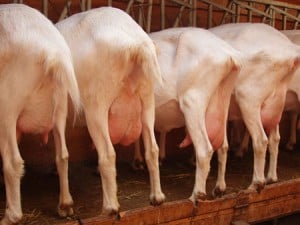Ewe’s milk is nasty. Actually, I have no idea what ewe’s milk tastes like. In fact, while I might be able to tell an ewe from a ram by the horns, that’s about the extent of my knowledge of sheep. Aside from seeing them in petting zoos, my life is pretty far removed from that of sheep. And I suspect the same is true of most contemporary Pagans. Which is why I am bewildered by the fact that nearly every Internet resource about the Neo-Pagan holiday in February, including all the obligatory annual blog posts, finds a way to mention ewe’s milk. Seriously? Ewww indeed.
 The reason, of course, is that the holiday is supposedly called “Oimelc” by some (who?), which means “ewe’s milk”. “Oimelc” actually is the name used by the Irish text, Tochmarc Emire (“The Wooing of Emer”), the primary source for the Irish cross-quarter days, along with Samhain, Beltane, and Bron Trogain (another name for Lughnasadh). The name more commonly used by Neo-Pagans is “Imbolc” (pron. im-olk), which comes from other Irish texts, and means “in the belly”.
The reason, of course, is that the holiday is supposedly called “Oimelc” by some (who?), which means “ewe’s milk”. “Oimelc” actually is the name used by the Irish text, Tochmarc Emire (“The Wooing of Emer”), the primary source for the Irish cross-quarter days, along with Samhain, Beltane, and Bron Trogain (another name for Lughnasadh). The name more commonly used by Neo-Pagans is “Imbolc” (pron. im-olk), which comes from other Irish texts, and means “in the belly”.
Personally, my February celebration has nothing to do with sheep or with milk — except that both are white and so is the snow on the ground outside right now. Where I live, in the Midwestern United States, the most salient fact about the weather right now is that it is freezing. On average, this is the coldest time of the year. This also means that it is about to start getting warmer. I would never call February the beginning of spring, though. It’s definitely the middle of winter. So, with my family, I call it “Mid-Winter”.
For me, mythologically, this is the time when the Goddess suckles (oh look, a milk reference!) the Sun Child, who grows stronger, as the Dark Lord continues to decline. The Sun Child becomes the Bright Youth, who is tested and then named and armed by the Goddess (three functions performed by right by the mother in Irish myth). The Bright Youth then triumphs over the Dark Lord. His triumph releases (i.e., melts) the waters which will purify the Goddess and transform her from the Crone into the Flower Maiden.
If Imbolc means “in the belly”, then I supposed it’s an okay name for the holiday, if we think of seeds waiting “in the belly” of the earth to come forth in the spring. But it’s still a bit archaic. The best alternative I have come up with is “Brigid”, which is the name actually used by Aidan Kelly (who is credited as the source of the Neo-Pagan Wheel of the Year) and later by Starhawk (in The Spiral Dance). I guess Imbolc caught on for consistency sake, so all the cross-quarter days would have Irish names. But Brigid is an Irish name, too. In fact, it’s the name of the goddess/saint associated with the date, who happens to have associations with the element of fire and water. Fire and water are the principal elements in our family Mid-Winter ritual. The central ritual act happens when we melt some snow in a kylix-like vessel (my “cauldron”) using four candles — black, red, green, white — representing the four faces of the goddess, a kind of “sympathetic magic” (except the “magic” works the opposite direction from what James Frazier described), and then we wash our hands in the cold water in a kind of purification rite.
Also, “Brigid” sounds like “frigid”, which it is right now. I know everyone will keep calling it “Imbolc”, but if we were going to change it, I would recommend “Brigid”. In the meantime, I’m going to continue to cringe every time I see a mention of ewe’s milk.
To close, here’s a cool Imbolc video:
SNOW + FIRE from Marie Julia Bollansée on Vimeo.















